Metronomes
Buyer's Guide
Talking about metronomes is likely to produce one of the following reactions from most guitarists:
- A frown, followed quickly by hitting the Back-Button on their browser...
- Loud snoring...
- An interest in how something that goes "click click click" can improve your skills.
If you fall into either of the first two camps, that's fine. The rest of us will understand. Enjoy browsing the rest of the site!
For the rest of you, this article is a Buying Guide and a How-To article specifically geared toward improving your guitar skills. You can read the page from top to bottom, or jump directly to one of the following topics:
What Is It? · What else can it do? · Buying Guide
Recommendations · Using One To Improve Guitar Skills
What is a metronome?
The purpose of a metronome is to keep a steady beat. The simplest produce an audible click or some other staccato sound. Many include blinking lights. Traditional-style metronomes use a swinging pendulum to keep track of the beat and help you to visualize the tempo.
The speed of the beat is adjustable. Electronic devices use a quartz timer for accuracy. Mechanical devices use a counter-weight on a swinging pendulum. Typical speeds for nearly all pendulums range from 40 bpm (beats-per-minute) to 208 bpm.
What else can it do?
All of them keep a steady beat. If that's all you need there are many inexpensive products to choose from. There are also inexpensive novelty styles that kids will love. Others are made of quality materials and can be left out as a decorative item. Many companies offer combination devices with numerous features.
Among the more popular features you can find are:
- A unique sound, or different colored light, on the downbeat (the first beat of the measure).
- A digitized swinging pendulum, so you can anticipate the beat.
- Built-in guitar tuner.
- Built-in drum beats, for more variety and fun.
- Multiple beat types: quarter-notes, eight-notes, triplets, and more.
- "Tap Tempo" setting (you tap the beat, and the metronome continues at that pace).
Buying Guide: What to Consider Before Buying
Sizes And ShapesWant a pocket-sized tempo-keeper? How about something that clips to your guitar-strap or ear for a private rock-steady beat? Looking for something you can leave out when discriminating company arrives? No problem. You'll find a wide variety of packages, including key-rings, headsets, and fine wood products.
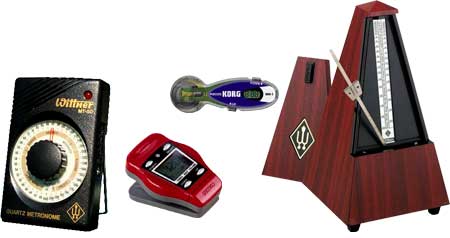 |
Controls And Displays
Also consider controls and display before making a selection. Here are some of the common options:
- Classic devices use a sliding weight on a pendulum with bpm markings. You slide the weight to the desired beat and let gravity and kinetic energy regulate the pace.
- Radio-button controls are often used on electronic metronomes to increase or decrease the pace.
- Large dials allow you to quickly spin to the right speed.
- Tap-Tempo Pads are great for playing along with a song or band-mates. Listen to their tempo; Tap in time on the pad; The device detects the pace of your tapping... Off you go!
Audible and Visible Beats
You might think all you need is a pleasant click, or simulated drum beat to practice along with. But, will you be able to hear anything over your guitar? If you like to play loud, select a device that includes a swinging pendulum (real or digitized), lights, or perhaps a headphone out jack.
Consider also the sound you'll hear. An old-fashioned metronome produces a nice woody click that sounds natural to the ear. You may not like some electronic beeps, boops, or clicks, so try to listen to a metronome before purchasing one (or read reviews, or make sure you can return it). You might also prefer simulated drum sounds rather than a simple click-click-click for keeping time. If you want something with more features and variability, you can spend more for a drum machine with very realistic sounds and enough options to use on stage.
Other features to Consider:
Over time it's the little things that slowly annoy you, so consider these other factors before making your purchase decision. These features may mean the difference between an indispensable device you'll use and love, or one that's tossed in a drawer, never to see the light of day again.
- Patterns
Preprogrammed beat patterns or beats that can be chained together, may be necessary for learning syncopated pieces... or just so you can have some fun. These beats range from simple beep-beep-beep's on less expensive devices, to realistic-sounding simulated drums on the more advanced and expensive boxes.
- Tuner
Many include a chromatic tuner, others have a simple 'reference tone' so you can tune one string by ear. Combining these common needs in one device makes a lot of sense.- Hygrometer
To care for your guitar, especially if you own an acoustic, you need to regulate the humidity to avoid playability problems or instrument damage. A hygrometer tells you the level of humidity so you know how to condition the air in your home. Combining multiple functions into one device reduces the number of boxes you need to carry or feed batteries to. For more on this topic see the Guitar Humidifier Guide.
- Beat Controls
You may only need a simple click-click-click quarter note beat, or you may need to hear triplets, or eighth notes, sixteenth notes, or some other pattern. Most electronic metronomes include the option to play all these beats, but make sure yours will, if you think you'll need them.
- Backlight, Clock, Headphone-Out
These may not mean much to you, or may be exactly what you need for using your device on-stage, keeping track of time, tracking song length, or ensuring that you can hear the beat.
Recommendations
These are popular and reliable:
| Perhaps unexpectedly, my first recommendation is for the online digital metronome from Seventh String Software. 40 to 208 BPM, tap tempo, and downloadable for off-line use. Cost: Free! | |
The
Korg TM-40 Digital Tuner/Metronome
|
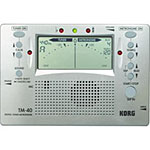 |
The
Boss DB-30 Dr. Beat
|
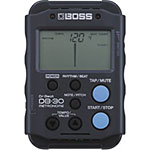 |
This great little unit, the
Matrix MR-500 Quartz
|
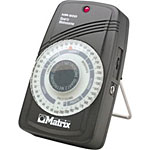 |
| The
Korg MM-1 MetroGnome
|
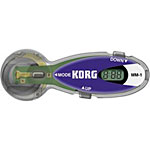 |
Using A Metronome To Improve Your Skills
The key benefits from using a metronome are:
- You establish a sense of internal timing (both consistency and speed).
- To determine the recommended tempo for playing written music.
- To put a little pressure on yourself and learn to play without hesitation.
If you don't think a metronome can help you...
Take The TestRecord yourself playing a song you're familiar with. If you don't want to record a song, then record yourself strumming a chord or two for about a minute. Tap your foot, bob your head, or use any other technique you normally use to play a nice, consistent tempo.
When you play the recording back, start a metronome. If you don't own one yet, use one of the online versions (such as the online metronome from Seventh String Software). Try to adjust the tempo of the metronome to match your playing. This might take a few tries.
If your playing is steady, it won't take much effort to match your playing to the reference beat. However, most beginners won't be able to get a consistent match. Why? Because you need to practice at a steady pace to play at a steady pace. That's why you need a metronome.
Using The Metronome - With Written Music
Most written music includes an indication of the intended tempo. If you look at the beginning of the piece (above the first measure for music notation) you may see a quarter-note followed by an equals sign and then a number. This number represents the recommended tempo. Alternatively, the tempo may be written with one of the standard tempo descriptions (e.g., Moderately, Lively, Allegro, Andante). Typically, instructions specify the bpm (beats-per-minute) for each standard term.
Once you know the recommended speed, you can set your practice speed at 1/3, or 1/2, or 3/4ths the performance speed. Slowly increase the tempo over time until you can play at the recommended speed. Playing faster than recommended can be great when preparing for a recital or band job.
Using The Metronome - To Improve Your Tempo and ConsistencyIf you incorporate the metronome into your routine practice: scales, strumming, warm-ups; you'll develop consistency of tempo. Set the bpm at a pace you can play comfortably. Then increase the tempo over time.
Using The Metronome - To Improve Your NervesSet the tempo at a comfortable pace and practice playing songs without stopping. If you mess up, don't repeat the passage, just skip what you messed up and keep going. This is about as close to playing with others as you can get. Adding this type of pressure in the comfort of your home will prepare you for performing for (and in front of) others.


